ABS AUDI R8 SPYDER 2015 Owners Manual
[x] Cancel search | Manufacturer: AUDI, Model Year: 2015, Model line: R8 SPYDER, Model: AUDI R8 SPYDER 2015Pages: 232, PDF Size: 58.36 MB
Page 13 of 232
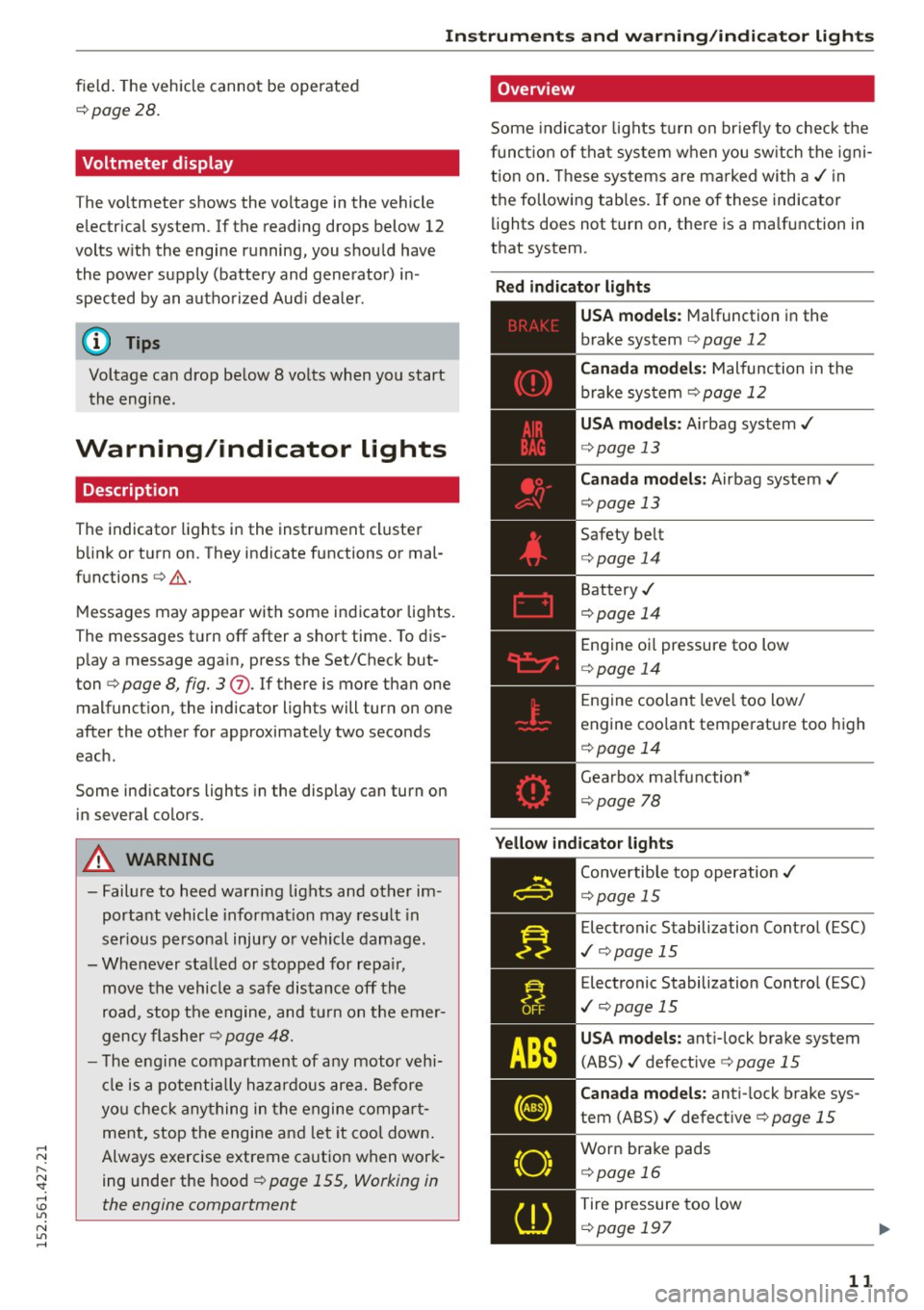
..... N
r-N "': ..... \!) 1.1'1
N 1.1'1 .....
Instruments and warning/indicator lights
field. The vehicle cannot be operated
c:;, page28.
Voltmeter display
The vo ltmeter shows the voltage in the vehicle
electrical system. If the reading drops below 12
volts w ith the engine running, you should have
the power supply (battery and generator) in
spected by an authorized Aud i dealer .
(D Tips
Voltage can drop below 8 volts when you start
the engine.
Warning/indicator lights
Descript ion
The indicator lights in the instrument cluster
blink or turn on. They indicate functions or mal
functions
c:;, ,&. .
Messages may appear with some indicator lights.
The messages turn
off after a short time. To dis
play a message aga in, press the Set/Check but
ton
c:;, page 8, fig. 3 (J) . If there is more than one
malfunction, the indicator lights will turn on one
after the other for approximately two seconds
each .
Some indicators lights in the display can turn on
in several colors.
A WARNING
- Failure to heed warning lights and other im
portant vehicle information may result in
serious persona l injury or vehicle damage.
- Whenever stalled or stopped for repa ir,
move the vehicle a safe distance off the
road, stop the engine, and turn on the emer
gency flasher
c:;, page 48.
-The engine compartment of any motor vehi
cle is a potentially hazardous area. Before
you check anything in the engine compart
ment, stop the engine and let it cool down.
Always exercise extreme caution when work
ing under the hood
c:> page 155, Working in
the engine compartment
Overview
Some indicator lights turn on briefly to check the
function of that system when you sw itch the igni
tion on. These systems are marked with a,/ in
the following tables. If one of these indicator
lights does not turn on, there is a ma lfunction in
that system.
Red indicator lights
---------------
US A models: Malfunction in the
brake system
c:;, page 12
Canada models: Malfunction in the
brake system
¢ page 12
USA models : Airbag system,/
c:> page 13
Canada models: Airbag system,/
c:>page 13
Safety belt
c:>page 14
Battery,/
c:>page 14
Engine oi l pressure too low
c:> page 14
Engine coolant leve l too low/
engine coo lant temperature too high
c:>page 14
Gearbox malfunction*
c:>page 78
Yellow indicator lights
Convertible top operation ,/
c:>page 15
Electronic Stabilization Control (ESC)
,I c:;,page 15
Electronic Stabilization Control (ESC)
,I c:;, page 15
USA models: ant i-lock brake system
(ABS) ,/ defect ive
c:;, page 15
Canada models: anti-lock brake sys
tem (ABS),/ defective
c:;, page 15
Worn brake pads
c:> page 16
Tire pressure too low
c:>page 197
11
Page 14 of 232
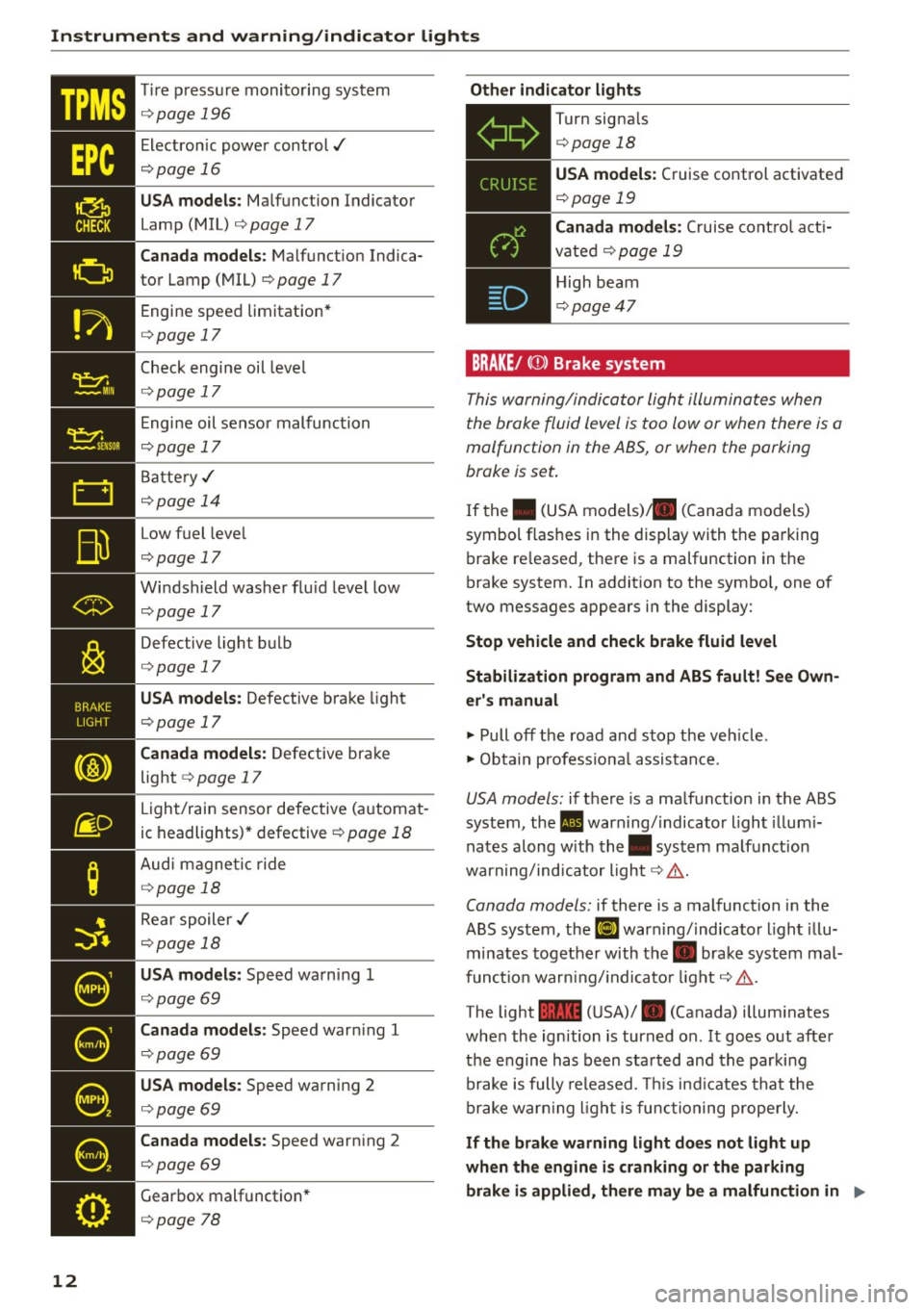
Instruments and warning/indicator lights
"t:::1: ~MI ii
12
Tir e p ress ure monito ring system
¢page 196
Electron ic power control../
¢page 16
USA models: Malfunction Indicator
Lamp (MIL) ¢
page 17
Canada models: Malfunction Indica
tor Lamp (MIL)
¢ page 17
Engine speed limitation *
¢page 17
Check engi ne oil level
¢ page 17
Engine oil senso r malfunction
¢page 17
Batte ry,/
¢ page 14
Low fuel leve l
¢page 17
Windshield washer flu id leve l low
¢page 17
Defective light b ulb
¢page 17
USA models: Defective bra ke light
¢page 17
Canada models: Defective bra ke
light ¢
page 17
Light/rain sensor defective (a utomat
ic headlights) * defective
¢ page 18
Aud i magne tic ride
¢ page 18
Rear spoiler .I
¢page 18
USA models: Speed wa rn ing 1
¢ page 69
Canada models: Speed war ning 1
¢page 69
USA models: Speed warning 2
¢page 69
Canada models: Speed warn ing 2
¢page 69
Gear box mal function *
¢page 78
Other indicator light s
Turn signals
¢ page 18
USA models : Cruise control activate d
¢page 19
BRAKE/ ((D) Brake system
This w arning/in dica tor light illumina tes when
the broke fluid level is too low or when there is a
malfunction in the ABS, or when the parking
brake is set .
If the . (U SA models) . (C anada mo de ls)
symbol f las hes i n the display with t he pa rking
b rake re leased, the re is a malfunction in the
brake system. In addit ion to the symbo l, one of
two messages appears in the display:
Stop vehicle and check brake fluid level
Stabilization program and ABS fault! S ee Own
er's manual
~ Pull off the road an d stop th e veh icle .
~ Obta in p rofess io na l assis tan ce .
USA mod els: if there is a ma lfunction in the ABS
system, the. warn ing/ indicato r light illum i
na tes a long w ith the . system ma lf u nction
war ning/ind icator light¢ ,&. .
Canada models: if there is a malfunction i n the
ABS system, the
EiJ warn ing/ indica tor ligh t il lu
minates together with the. brake syst em mal
f unc tion war ning/ indica to r lig ht ¢,&. .
The light
1111 ( U SA)/ . (Canada) illum inates
whe n the ign ition is turned on. I t goes o ut afte r
the engin e has be en sta rted and th e p arkin g
brake is fully re leased. This ind icates that th e
br ake warn ing lig ht is func tioning properly.
If the brake warning light does not light up
when the engine is cranking or the parking
brake is applied, there may be a malfunction in
1111>
Page 15 of 232

..... N
r-N "': ..... \!) 1.1'1
N 1.1'1 .....
Instrument s and warning /indicator ligh ts
the electrical system . In thi s case, conta ct your
Audi de ale r.
If the ABS fails, the ABS warning/ind icator light
II (USA mode ls)/ ii] (Canada mode ls) flashes to
gether with the brake system warning/indicator
light¢ &.
(USA models):
If the wa rning light~ and the
warn ing light
riJ ill umina te together, immed i
ately contact your authorized Audi dea ler or
qua lified workshop to have all brake pads in
spected ¢
page 16.
When the light comes on, an audib le warn ing sig
na l is also given .
Parking brake set
The parking brake warning light./. (Canada
models) illuminates when the park ing brake is
set. In add ition, a warning tone will so und afte r
you have driven for longer than 3 seconds and
faster than
3 mph (5 km/h).
P ar king brake set
The ~ warning/ind icator light illuminates
when the parking brake is set¢,&. .
_& WARNING
-Always observe the w arnings in
¢ page 155, Working in the engine com
partment, before opening the engine hood
and checking the b rake fluid .
- Driving with low brake fluid is a safety haz
ard! Stop the car and get professional assis
tance.
- USA models: If both, the~ warning
light and the
II warning light come on at
the same time, the rear whee ls cou ld lock
up first under hard braking. lock-up of the
rear wheel brakes can cause loss of veh icle
control and an accident. Have your vehicle
repai red immediately by your author ized
Audi dealer or a qualified wo rkshop. Dr ive
slowly and avoid sudden, ha rd b rake appli
cat ion .
- Canada models: If both, the brake warning
ligh t. and the ABS warning light
ii] come
on at the same time, the rear whee ls co uld
lock up first under har d braking. lock -up of the rear wheel brakes can cause
loss of vehi
cle control and an accident. Have your veh i
cle repaired immed iately by your authorized
Aud i deale r or a qua lified workshop. Drive
slowly and avo id sudden, hard brake appli
cation.
- If the brake warning/ind icator light does
not go out after a few seconds and the pa rk
ing brake is released, or lights up wh ile you
are driving, the fl uid level in the brake flu id
reservoir is too low.
If you believe that it is
safe to do so, proceed immedia tely at low
speed to the nearest authorized A udi dealer
or qualified workshop and have the brake
system inspected.
- Always keep in mind that after severa l brake
applications, you will need greater press ure
on the brake pedal to stop your vehicle. Do not rely on strained brakes to respond with
maximum stopp ing power in cr itical s itua
tions . You must allow for increased braking
distances. The ext ra d istance used up by
fading brakes could lead to an accident.
tli1 !'! r Safety systems
T he . (USA models), . (Canada mode ls) indi
cator lig ht monitors the safety sys tems e.g. air
bags, pretensioners and ill uminates for a few
seconds each time you switc h the ignition on .
If the . (USA models)/ . (Canada models) in
dicator light does not go ou t, o r if i t illumin ates
whi le you a re d riving, or if it starts to blink, then
t h ere is a ma lfunction somewhere in the system .
If the light does not illum inate when yo u switch
on the ignition, this also means there is a ma l
funct ion.
_& WARNING
-If you have a ma lfunction in the safety sys-
tems, contact you r authorized Audi dea le r i m
mediately. Otherwise the safety systems may
not wor k properly in an accident.
13
Page 17 of 232
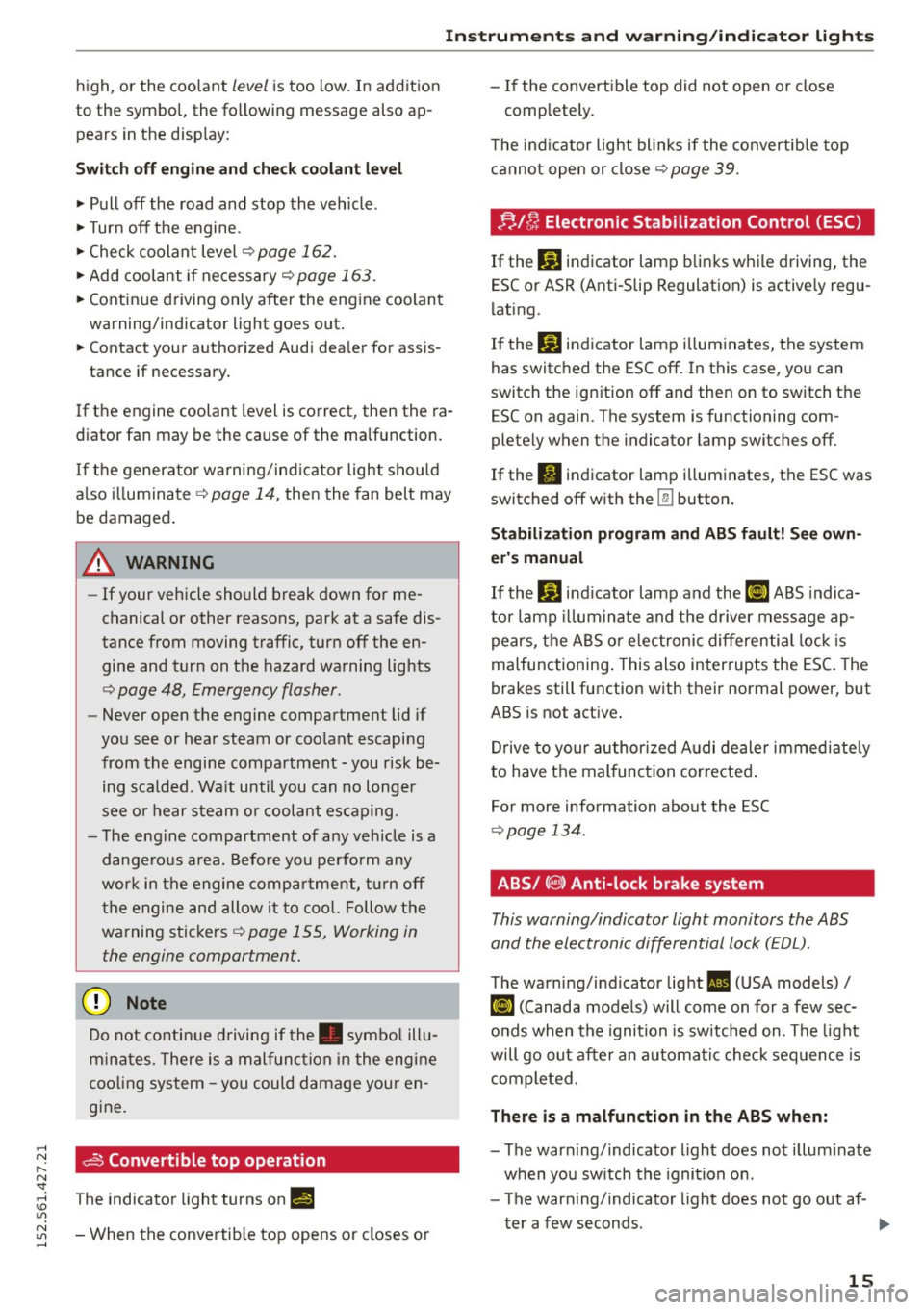
..... N
r-N "': ..... \!) 1.1'1
N 1.1'1 .....
Instrument s and warning /indicator ligh ts
high, or the coolant level is too low. In addition
to the symbo l, the following message also ap
pears in the disp lay:
S w itc h off en gin e and ch ec k coo lant l ev e l
.. Pull off the road and stop the vehicle .
.. Turn off the engine .
.. Check coolant level~
page 162.
.. Add coolant if ne cessary ~ page 163 .
.. Continue d riving only after the engine coolant
warning/indicator light goes out .
.. Contact your authorized Audi dea ler for ass is-
tance if necessary.
I f the engine coolant level is correct, then the ra
diator fan may be the cause of the malfunction.
If the generator wa rning/ind icator light shou ld
a lso i lluminate
~ page 14, then the fan belt may
be damaged .
A WARNING
-If your vehicle should break down for me
chanical or other reasons, park at a safe dis
tance from moving traffic, turn off the en
gine and turn on the hazard warning lights
~ page 48, Emergency flasher.
- Never open the engine compartment lid if
you see or hear steam or coo lant escaping
from the engine compartment - you risk be
ing scalded . Wa it until you can no longer
see or hear steam or coolant escaping .
- The engine compartment of any veh icle is a
dange rous area. Before you perform any
wor k in the engine compa rtment, t urn off
the engine and allow it to coo l. Follow the
warning stic kers
~ page 155, Working in
the engine compartment .
(D Note
Do not co nti nu e d riving if the. symbo l ill u
m inates. There is a mal function in the engine
cooling system -you could damage your en
gine .
dS Convertible top operation
The ind icator light tu rns on II!
- When the convertib le top opens or closes or -
If the convert ible top did not open or close
comp letely .
T he ind icator light blinks if the convertib le top
cannot open or close
~ page 39.
;;./ !'r, Electronic Stabilization Control (ESC)
Ifthc DJ indicator lamp blinks while driving, the
ESC or ASR (Anti-Slip Regulation) is actively regu
lating.
If the
DJ indicator lamp illum inates, the system
has switched the ESC off. In this case, you can
switch the ignition off and then on to switch the
ESC on aga in. The system is functioning com
ple tely when the indicator lamp switches off.
If the
II indicator lamp illuminates, the ESC was
switched off with the
[ru button .
Stabilizati on progr am and ABS fault! S ee ow n
e r's manual
If the Bl ind icator lamp and the [i] ABS indica
tor lamp illum inate and the d river message ap
pears, the ABS or e lectronic differentia l lock is
malfunctioning . This also interrupts the ESC. The
brakes still function with their normal power, but
ABS is not active .
Drive to your authorized A udi dealer immed iate ly
to have the mal func tion corrected .
Fo r more information about the ESC
~ page 134.
ABS/ (0 ) Anti-lock brake system
This warning/indicator light monitors the ABS
and the electronic differential lock (EDL).
The warning/indicator light Ill (USA models)/
¢ ~)
will go out after an automa tic check sequence is
completed.
There is a malfunction in the ABS when:
- The warning/indicator light does not illum inate
when you sw itch the ignition on .
- The warning/indicator light does not go out af -
ter a few seconds . ..,
15
Page 18 of 232
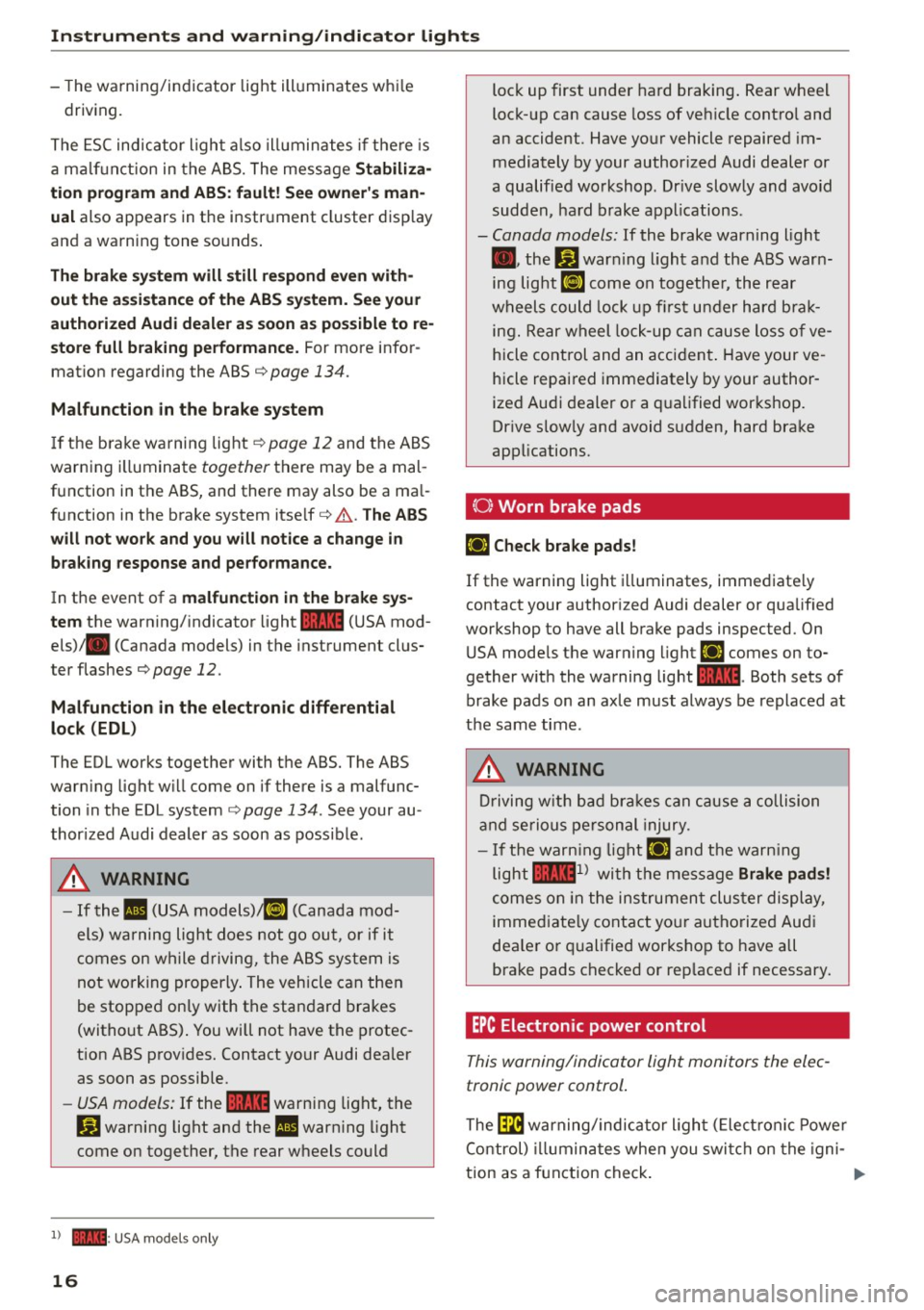
Instruments and warning /indicator light s
-The warning/indicator light ill uminates whi le
driving.
The ESC ind icator light a lso illuminates if there is
a ma lf u nction in the ABS. The message
Stabiliza
tion p rogr am and ABS: fault! See o wner 's man
ual
also appears in the instr ument cluster disp lay
and a warning tone sounds .
The b rake sy stem will still respond even with
out the ass is tance of th e ABS sy stem. See your
a utho riz ed Audi dealer a s soon as po ssible to re
s tore full braking perfo rmance.
For more infor
mat ion regarding the ABS
¢ page 134.
Malfunction in th e brake s ystem
If the b rake warning light¢ page 12 and the ABS
warning i lluminate
together there may be a mal
function in the ABS, and there may also be a ma l
function in the brake system itself ¢ & .
The ABS
will not wo rk and you w ill notice a change in
bra king response and per formance.
In the event of a malfun ct ion in the br ake sy s
tem
the warning/indicator light 1111 (USA mod
els)/ . (Canada models) in the instrument clus
ter flashes¢
page 12.
Malfunction in th e electronic diffe renti al
lock (EDL )
The EDL works together with the ABS. The ABS
warn ing light w ill come on if there is a malfunc
tion in the EDL system¢
page 134 . See your au
thor ized Audi dealer as soon as possible.
.&_ WARNING
- If the II (USA models) ;tiJ (Canada mod
els) warning light does not go out, or if it
comes on while driving, the ABS system is
not working properly . The vehicle can then
be stopped only with the standard brakes
(without ABS) . You will not have the protec
t ion ABS prov ides. Contact your Audi dealer
as soon as possible.
- USA models: If the 1111 warning light, the
J_i) warning light and the II warn ing light
come on together, the rear wheels could
l ) - : USA models only
16
-
lock up first under hard braking . Rear wheel
lock- up can cause loss of veh icle contro l and
an accident. Have your vehicle repaired im mediately by your author ized Audi dealer or
a qualified workshop. Dr ive slowly and avoid
sudden, ha rd brake applications.
- Canada models: If the brake warning light
• • the
JjJ warn ing light and the ABS warn
ing light
EIJ come on togethe r, the rear
wheels could lock up fi rst under hard bra k
ing. Rear wheel lock-up can c ause loss o f ve
hicle control and an accident. Have your ve
hicle repai red immediately by your author
ized Audi dealer or a qualified workshop.
Dr ive slow ly and avoid sudden, hard brake
applications.
(0) Worn brake pads
£i1 Check brake pads!
If the warning light i lluminates, immediate ly
contact your authorized Audi dealer or qualified
workshop to have all brake pads inspected. On
USA mode ls the warning light £i1 comes on to·
gether w ith the warning light 1111 . Both sets of
brake pads on an ax le must always be replaced at
the same time .
.&_ WARNING
Driving w ith bad bra kes can cause a collision
and se rious personal injury.
- If the warn ing light
£i1 and the warn ing
light
llll1 l with the message Brake pad s!
comes on in the ins trumen t clus ter display,
immed iate ly contact yo ur authorized Audi
dea le r or q ualified workshop to have all
brake pads checked or rep laced if necessary.
EPC Electronic power control
This warning/indicator light monitors the elec
tronic power control .
The~ warning/indicator l igh t (E lec tronic Powe r
Control) illuminates when you swi tch on the igni
tion as a function check .
Page 98 of 232
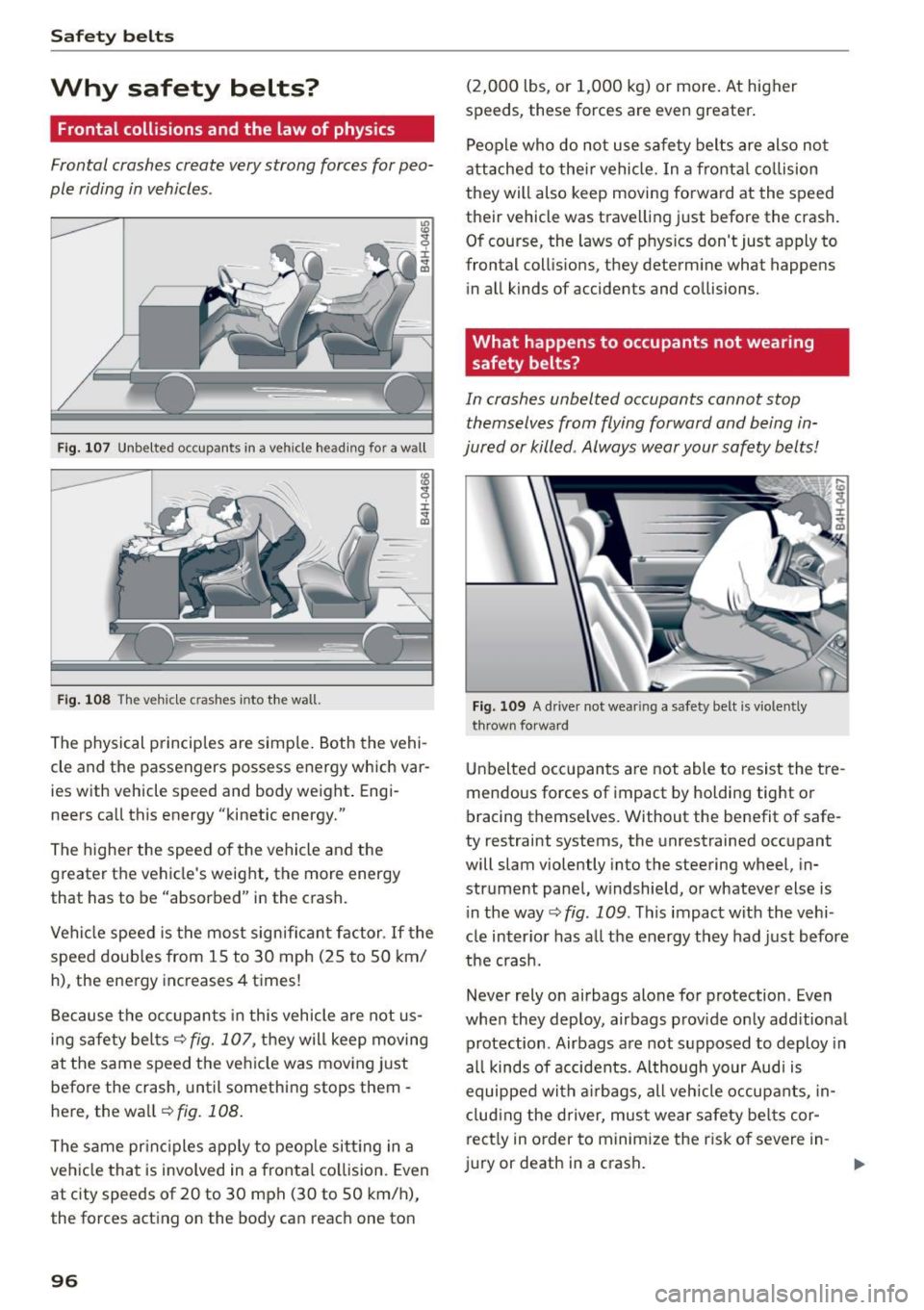
Safety belts
Why safety belts?
Frontal collisions and the law of physics
Frontal crashes create very strong forces for peo
ple riding in vehicles .
Fig. 107 Unbelted occupants in a veh icle heading for a wall
Fig. 108 The vehicle c rashes into the wall.
The physical principles are simple. Both the vehi
cle and the passengers possess energy which var
ies w ith vehicle speed and body weight . Engi
neers call this energy "kinetic energy."
The higher the speed of the vehicle and the
greater the vehicle's weight, the more energy
that has to be "absorbed" in the crash.
Vehicle speed is the most significant factor. If the
speed doubles from 15 to 30 mph (25 to 50 km/
h), the energy increases 4 times!
Because the occupants in this vehicle are not us
ing safety belts
c::> fig. 107, they will keep moving
at the same speed the vehicle was moving just
before the crash, until something stops them -
here, the wall
¢ fig. 108 .
The same principles apply to people sitting in a
vehicle that is involved in a frontal collision. Even
at c ity speeds of 20 to 30 mph (30 to SO km/h),
the forces acting on the body can reach one ton
96
(2,000 lbs, or 1,000 kg) or more. At higher
speeds, these forces are even greater.
People who do not use safety belts are also not
attached to their vehicle. In a frontal collision
they will also keep moving forward at the speed
their vehicle was travelling just before the crash.
Of course, the laws of phys ics don't just apply to
frontal collis ions, they determine what happens
in all kinds of accidents and collisions.
What happens to occupants not wearing
safety belts?
In crashes unbelted occupants cannot stop
themselves from flying forward and being in
jured or killed . Always wear your safety belts!
Fig. 109 A drive r not wea ring a safety belt is v io lently
t hrown forward
Unbelted occupants are not able to resist the tre
mendous forces of impact by holding tight or
bracing themselves. Without the benefit of safe
ty restraint systems, the unrestrained occupant
will slam violently into the steering wheel, in
strument panel, w indshield, or whatever else is
i n the way
c::> fig . 109 . This impact with the vehi
cle inter ior has all the energy they had just before
the crash.
Never rely on airbags alone for protection. Even
when they deploy, airbags provide only add itional
protection . Airbags are not supposed to deploy in
all kinds of accidents . Although your Audi is
equipped with airbags, all vehicle occupants, in
cluding the driver, must wear safety belts cor
rect ly in order to minimize the r isk of severe in-
jury or death in a c rash.
ll-
Page 99 of 232
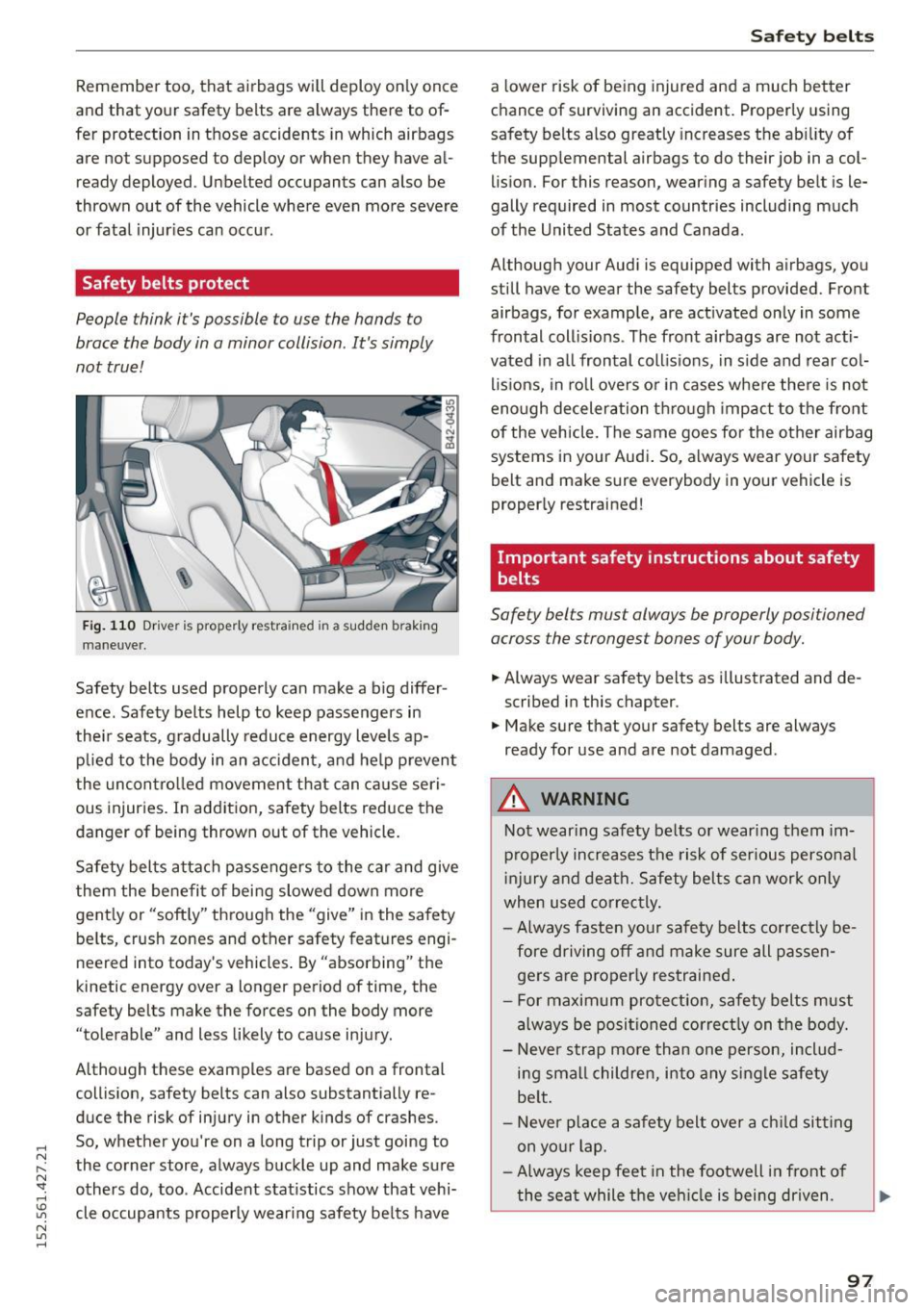
.... N
l'
N "1: .... I.O
"' N
"' ....
Remember too, that airbags will deploy only once
and that your safety belts are always there to of
fer protection in those accidents in which airbags
are not supposed to deploy or when they have al ready deployed . Unbelted occupants can also be
thrown out of the vehicle where even more severe
or fatal injuries can occur .
Safety belts protect
People think it's possible to use the hands to
brace the body in a minor collision . It 's simply
not true!
Fig. 110 Dr ive r is properly restrained in a sudden b raking
maneuver.
Safety belts used properly can make a big differ
ence. Safety belts help to keep passengers in
the ir seats, gradually reduce energy levels ap
plied to the body in an accident, and help prevent
the uncontro lled movement that can cause seri
ous injuries. In addition, safety belts reduce the
danger of being thrown out of the vehicle.
Safety belts attach passengers to the car and give
them the benefit of being slowed down more
gently or "softly '' through the "give" in the safety
belts, crush zones and other safety features engi
neered into today's vehicles . By "absorbing" the
kinetic energy over a longer period of time, the
safety belts make the forces on the body more
"tolerable" and less likely to cause injury.
Although these examples are based on a frontal collision, safety belts can also substantially re
duce the risk of injury in other kinds of crashes .
So, whether you're on a long trip or just going to
the corner store, always buckle up and make sure others do, too. Accident stat istics show that vehi
cle occupants properly wearing safety be lts have
Safety belts
a lower risk of being injured and a much better
chance of surviving an accident. Properly using
safety belts also greatly increases the ability of
the supp lemental airbags to do their job in a col
lision. For this reason., wearing a safety belt is le
gally required in most countries including much
of the United States and Canada.
Although your Audi is equipped with airbags, you
still have to wear the safety belts provided. Front airbags, for example, are activated only in some
frontal coll isions. The front airbags are not acti
vated in all frontal collisions, in side and rear col
lisions, in roll overs or in cases where there is not
enough deceleration through impact to the front
of the vehicle. The same goes for the other airbag
systems in your Audi . So, always wear your safety
belt and make sure everybody in your vehicle is
properly restrained!
Important safety instructions about safety
belts
Safety belts must always be properly positioned
across the strongest bones of your body.
• Always wear safety belts as illustrated and de
scribed in this chapter.
• Make sure that your safety belts are always
ready for use and are not damaged.
A WARNING
-Not wearing safety belts or wearing them im-
properly increases the risk of ser ious personal
in jury and death. Safety belts can work only
when used correctly.
- Always fasten your safety belts correctly be
fore driving off and make sure all passen
gers are properly restrained .
- For maximum protection, safety belts must
always be positioned correctly on the body.
- Never strap more than one person, includ
i ng smal l children, into any single safety
be lt.
- Never plac e a safety belt over a child sitting
on your lap .
- Always keep feet in the footwell in front of
the seat while the vehicle is being driven .
97
Page 108 of 232
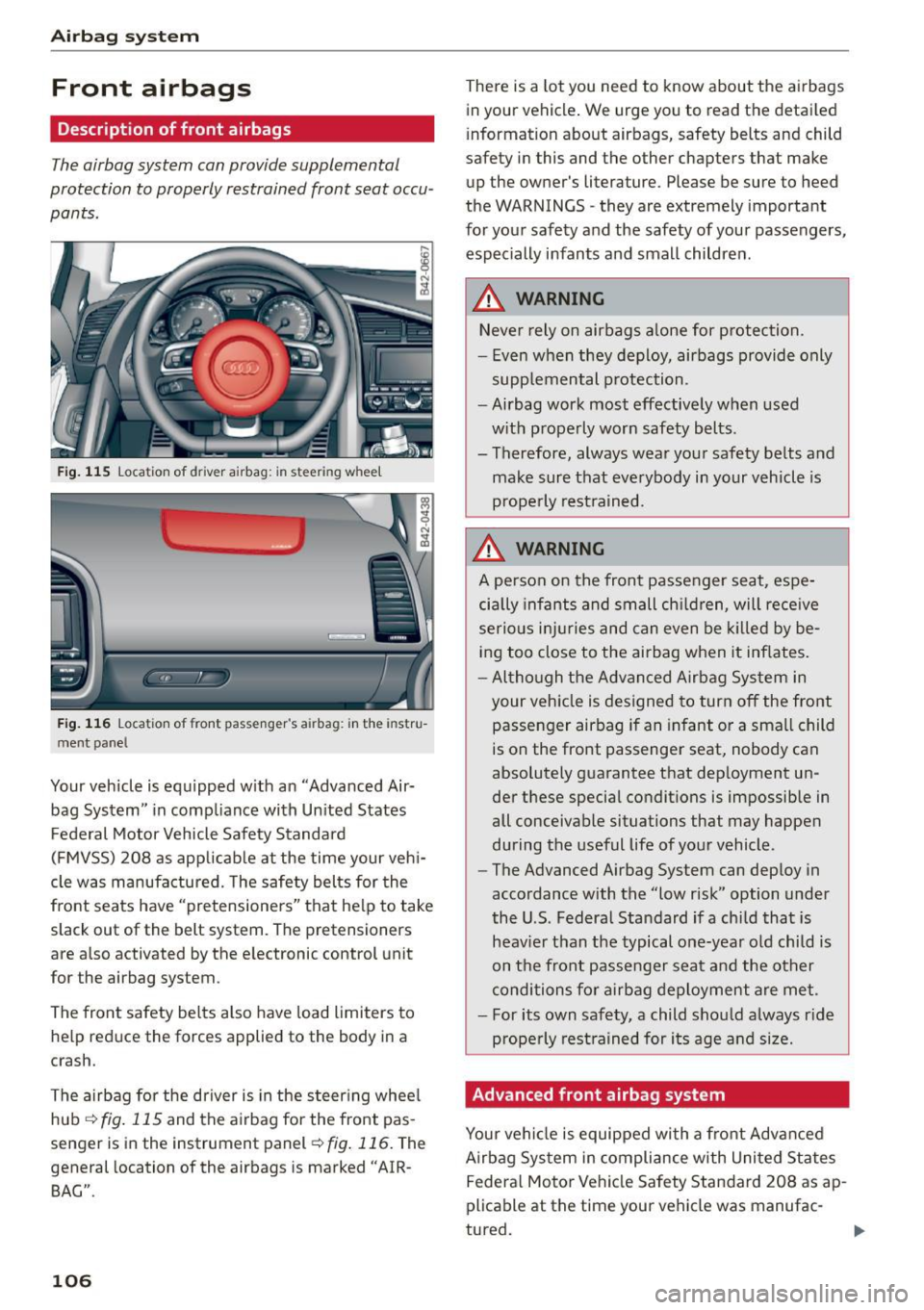
Airb ag syst em
Front airbags
Description of front airbags
The airbag system can provide supplemental
protection to properly restrained front seat occu
pants .
Fig. 115 Location of driver airbag : in steering whee l
Fig. 116 Location of front passenger's airbag: in the instru
ment panel
Your vehicle is equ ipped with an "Advanced Air
bag System" in comp liance with Un ited States
Federal Motor Vehicle Safety Standard
(FMVSS) 208 as applicab le at the time your veh i
cle was manufactured. The safety belts for the
front seats have "pretensioners" that he lp to take
slack out of the belt system. The pretensioners
are also activated by the electronic control unit
for the airbag system.
The front safety belts a lso have load limiters to
help reduce the forces applied to the body in a
crash.
The airbag for the driver is in the steer ing wheel
hub
¢ fig . 115 and the airbag for the front pas
senger is in the instrument panel¢
fig. 116. The
general location of the airbags is marked "AIR
BAG".
106
There is a lot you need to know about the airbags
in your vehicle . We urge you to read the detailed
i nformation about airbags, safety belts and child
safety in this and the other chapters that make
up the owner's literature. Please be sure to heed
the WARNINGS -they are extremely important
for your safety and the safety of your passengers, especially infants and small children .
,&_ WARNING -
Never rely on airbags alone for protection.
- Even when they deploy, airbags provide only supp lemental p rotection.
- Airbag work most effectively when used with properly worn safety belts .
- Therefore, always wear your safety be lts and
make sure that everybody in your vehicle is
prope rly restrained.
,&_ WARNING
A person on the front passenger seat, espe
cially infants and small ch ild ren, will rece ive
serious i njur ies and can even be killed by be
ing too close to the airbag when it inf lates .
- Although the Advanced Airbag System in your vehicle is designed to turn off the front passenger airbag if an infant or a sma ll child
is on the front passenger seat, nobody can
absolutely guarantee that dep loyment un
der these special condit ions is impossible in
all conceivable situations that may happen
during the useful life of your vehicle .
- The Advanced Airbag System can dep loy in
accordance with the "low risk" option under
the U .S. Federal Standard if a chi ld that is
heav ier than the typical one-year old child is
on the front passenger seat and the other
conditions for airbag deployment are met.
- For its own safety, a child shou ld always r ide
prope rly rest rained for i ts age a nd si ze.
Advanced front airbag system -
Your vehicle is equipped with a front Advanced
Airbag System
in compliance with United States
Federa l Motor Vehicle Safety Standard 208 asap
plicable at the time your vehicle was manufac
tured.
Page 110 of 232
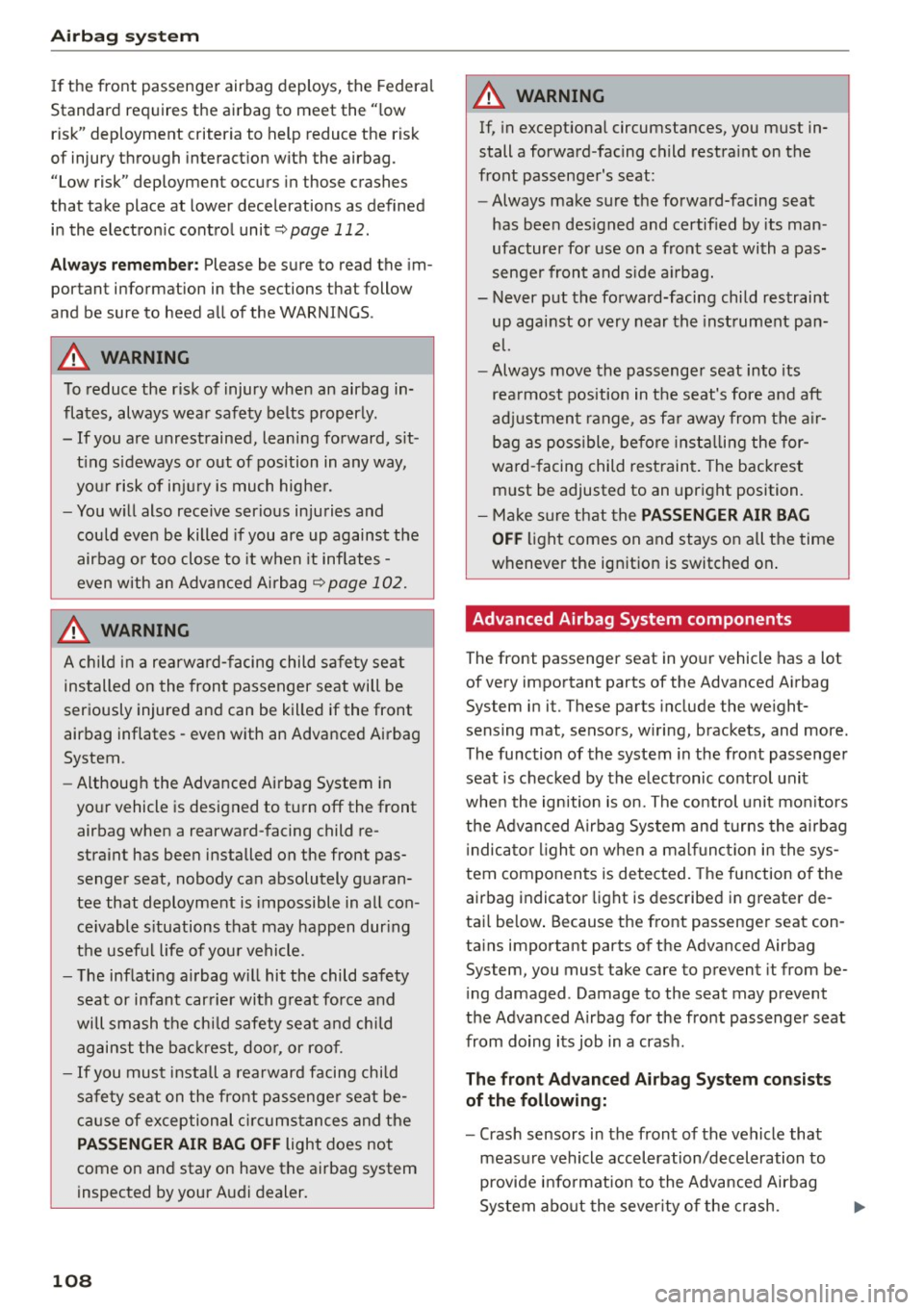
Airbag syste m
If the front passenger airbag deploys, the Federal
Standard requires the airbag to meet the "low
risk" deployment criteria to help reduce the risk
of injury through interaction with the airbag.
"Low risk" deployment occurs in those crashes
that take place at lower decelerations as defined in the electron ic control unit
<:;> page 112.
Always remember: Please be sure to read the im
portant information in the sections that follow
and be sure to heed a ll of the WARNINGS .
A WARNING
To reduce the risk of injury when an airbag in
flates, always wear safety belts properly.
- If you are unrestrained, leaning forward, sit
t ing s ideways o r out of position in any way,
you r risk of inju ry is much highe r.
- You w ill also receive serious injuries and
could even be killed if you are up against the
airbag or too close to it when it inflates -
even with an Advanced Airbag
<:;>page 102.
A WARNING
A child i n a rearward-facing child safety seat
installed on the front passenger seat will be
seriously injured and can be killed if the front
airbag inflates -even with an Advanced Airbag
System.
- Although the Advanced Airbag System in
yo ur vehicle is designed to turn off the front
airbag when a rearward-facing child re
straint has been installed on the front pas
senger seat, nobody ca n absolutely guaran
tee that deployment is impossible in all con
ceivable s ituations that may happen dur ing
the useful life of you r vehicle.
- The inflating a irbag w ill hit the child safety
seat or infant carrier with great force and
will smash the chi ld safety seat and chi ld
against the bac krest, doo r, or roof.
- If you must install a rearward facing child
sa fety seat on the front passenge r seat be
ca use of exceptional c ircumstances and the
PASSENGER AIR BAG O FF light does not
come on and stay on have the airbag system
inspected by your Audi dealer.
108
A WARNING , ~
If, in exceptiona l circumstances, you must in
stall a forward-facing child restra int on the
front passenger's seat:
- Always make sure the forward-facing seat
has been des igned and certified by its man
ufacturer for use on a front seat with a pas
senger front and s ide a irbag.
- Never put the forward-facing child restraint
up against or very near the inst rument pan
el.
- Always move the passenger seat into its
rea rmost position in t he seat's fore and aft
adjustment range, as fa r away from the a ir
bag as poss ible, be fore insta lling the for
ward-facing child restrain t. T he backrest
m ust be adjusted to an upr ight position.
- Ma ke s ure that the
PAS SENGER AIR BAG
OFF
li ght comes on and stays on all the time
wheneve r the ignition is switched on .
Advanced Airbag System components
The front passenger seat in your vehicle has a lot
of very important parts of the Advanced Airbag
System in it. These parts include the weight
sensing mat, sensors, wiring, brackets, and more.
The function of the system in the front passenger
seat is checked by the e lectronic control unit
whe n the ignition is on. The control unit mo nitors
the Advanced Airbag System and t urns the a irbag
i ndicator light on when a malf unct ion in the sys
tem components is detected. The function o f the
airbag indicator light is described in greater de
tai l below . Because the front passenger seat con
ta ins important parts of the Advanced Airbag
System, you must take care to prevent it from be
i ng damaged . Damage to the seat may prevent
the Advanced A irbag for the front passenger seat
from doing its job in a cras h.
The f ront Ad van ced Airbag S ystem consi sts
of the following:
- Crash sensors in the front of the vehicle that
measu re vehicle acceleration/deceleration to
provide i nfo rmation to the Advanced Airbag
System about the sever ity of the crash.
Page 118 of 232
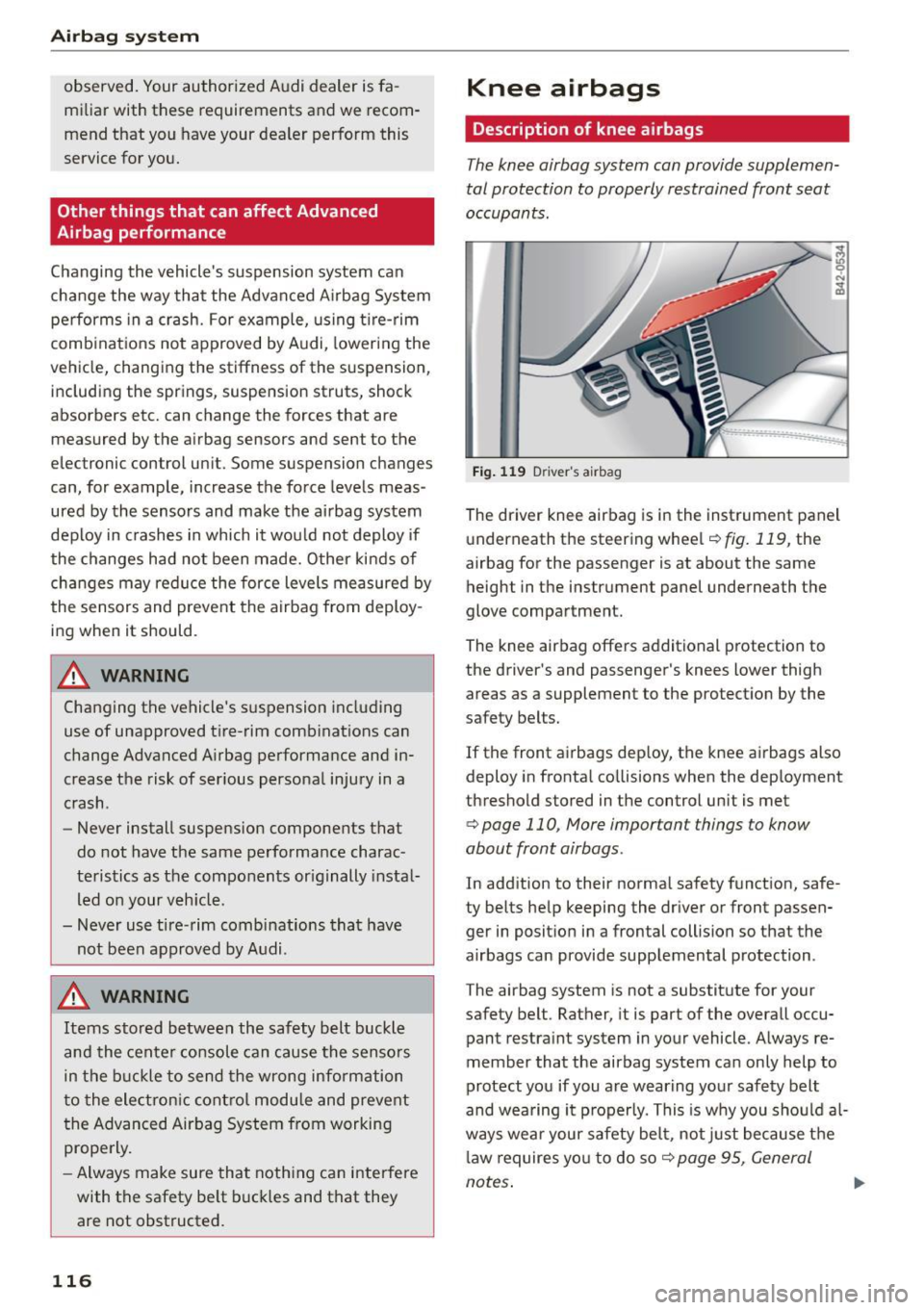
Airb ag syst em
observed. Your authorized Audi dealer is fa
miliar with these requirements and we recom
mend that you have your dealer perform this
service for you.
Other things that can affect Advanced
Airbag performance
Changing the vehicle's suspension system can
change the way that the Advanced Airbag System
pe rforms in a crash. For example, us ing t ire-rim
comb inat ions not approved by Audi, lowering the
vehicle, changing the stiffness of the suspension, including the springs, suspension struts, shock
absorbers etc. can change the forces that are measured by the airbag sensors and sent to the
electronic control unit. Some suspension changes
can, for example, increase the force levels meas
ured by the sensors and make the airbag system
deploy in crashes in which it wou ld not deploy if
the changes had not been made. Other kinds of
changes may reduce the force levels measured by
the sensors and prevent the airbag from deploy
ing when it should.
A WARNING
Changing the vehicle's s uspension including
use of unapproved t ire-rim comb inat ions can
change Advanced A irbag performance and in
crease the risk of ser ious persona l injury in a
crash .
- Never install suspension components that
do not have the same performance charac
te ristics as the components or iginally insta l
led on your veh icle.
- Never use tire-rim combinations that have not been approved by A udi.
A WARNING
Items stored between the safety belt buckle
and the center console can cause the senso rs
in the b uck le to send the wrong information
t o the electron ic contro l modu le and prevent
t he Advanced Airbag System from working
properly.
- Always make sure that nothing can interfere
with the safety be lt b uckles and that they
are not obstructed.
116
Knee airbags
Description of knee airbags
The knee airbag system can provide supplemen
tal protection to properly restrained front seat
occupants .
Fig. 119 D river 's airbag
The driver knee airbag is in the instrument panel
u nderneath the steer ing whee l
~fig. 119, the
airbag for the passenger is at about the same height in the instrument panel underneath the
glove compartment.
The knee airbag offers additional protection to
the driver's and passenger's knees lower thigh
areas as a supplement to the protection by the
safety belts.
If the front a irbags dep loy, the knee a irbags also
deploy in fronta l co llisions when the dep loyment
threshold stored in the control unit is met
~ page 110 , More important things to know
about front airbags .
In addition to their normal safety function, safe
ty belts help keeping the driver or front passen ger in posit ion in a frontal collision so that the
airbags can provide supplemental protection .
The airbag system is not a substitute for your
safety belt . Rather, it is part of the overall occu
pant restra int system in your vehicle. A lways re
member that the airbag system can only help to
protect you if you are wearing your safety belt
and wea ring it p roperly. This is why you sho uld a l
ways wear your safety be lt, not just because the
l aw requires yo u to do so¢
page 95, General
notes .
llll-